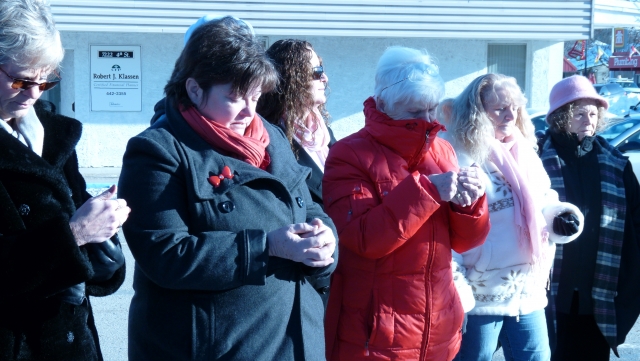Women's Coalition commemorates 1991 Montreal Massacre
The 21st anniversary of the Montréal Massacre, a tragic act of gender-based violence that left 14 young women dead was recognized on Dec. 6. The Boundary Women’s Resource Centre organized two memorial events – a ceremony and lowering of the flag at city hall for the day and a film event in the evening. A small group gathered for the flag lowering ceremony in the morning. Sheila Dobie spoke about the need to continue to ensure women are safe in their communities, and explained that the issue is not just a woman’s problem. Education for men to help create safety is critical as well. “A couple of things have happened in my life that demonstrates the importance of putting this (topic) in its place,” said Dobie. “Yes, we need to educate women about the violence that happens to them, but let’s acknowledge and see the importance of men and the responsibility.” The flag was lowered by Peter Matheson, with assistance from Ross Idler, while Diane Lapalme read off the names of the women murdered in Montreal as well as women who have died of violence in the Boundary. The group held a moment of silence in remembrance. In 1991, the Government of Canada designated December 6 as Canada’s annual National Day of Remembrance and Action on Violence against Women. The National Day of Remembrance and Action on Violence against Women falls in the middle of the worldwide 16 Days of Activism against Gender Violence, which runs from November 25, the International Day for the Elimination of Violence against Women, to December 10, International Human Rights Day. Violence against women and girls remains a serious problem in Canada, from overt acts of hatred, such as the Montréal Massacre, to culturally based offences and everyday acts of coercion, such as sexual harassment and domestic abuse.
- Women and girls are more likely to experience certain types of serious violence and assault:
- on average, 178 females were killed every year between 1994 and 2008;
- in 2008, there were 146 female victims of homicide in Canada. Of these, 45 were victims of spousal homicide; and
- young women are particularly vulnerable. Between 1997 and 2006, young women (aged 15 to 24) were killed at a rate nearly three times higher than for all female victims of spousal homicide. During the same period, the rate of sexual assault for girls (under age 18) by family members was four times higher than for boys.
- Some groups of women in Canada are particularly vulnerable to violence:
- the spousal homicide rate for Aboriginal women is more than eight times that for non-Aboriginal women;
- immigrant women may be more vulnerable to family violence due to, among other things, economic dependence, language barriers, and lack of access to resources; and
- senior women are twice as likely as senior men to be victims of violent crime perpetrated by a family member.






















